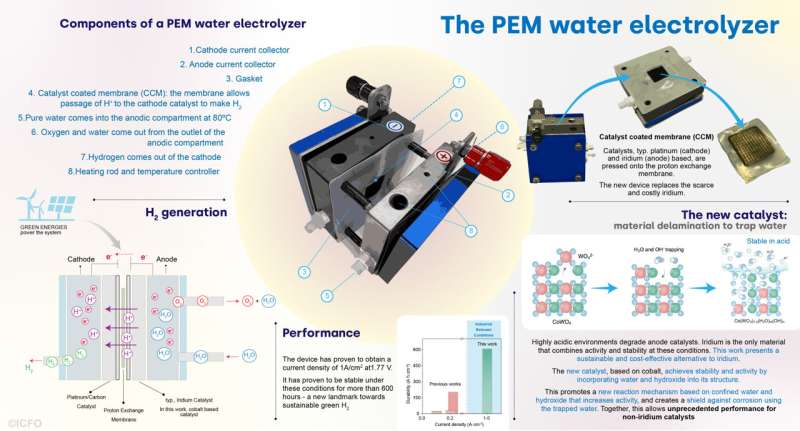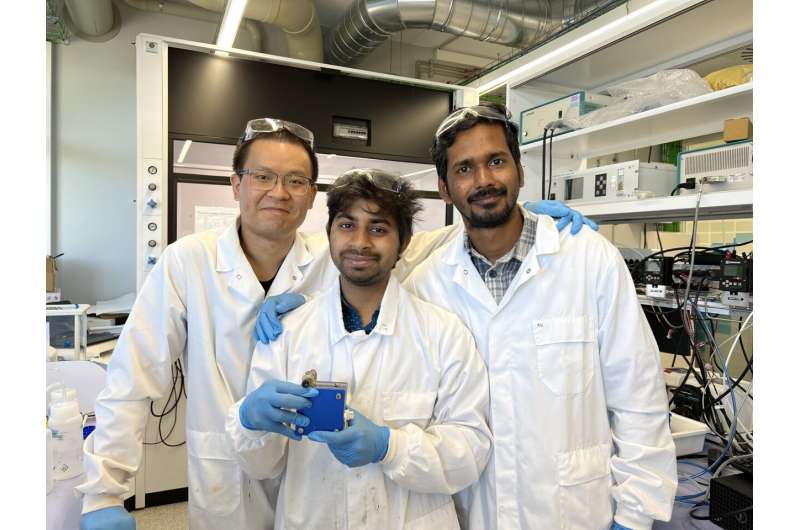This article has been reviewed according to Science X's editorial process and policies. Editors have highlighted the following attributes while ensuring the content's credibility:
fact-checked
peer-reviewed publication
trusted source
proofread
New catalyst unveils the hidden power of water for green hydrogen generation

Hydrogen is a promising chemical and energy vector to decarbonize our society. Unlike conventional fuels, hydrogen utilization as a fuel does not generate carbon dioxide in return. Unfortunately, today, most of the hydrogen that is produced in our society comes from methane, a fossil fuel. It does so in a process (methane reforming) that leads to substantial carbon dioxide emissions. Therefore, the production of green hydrogen requires scalable alternatives to this process.
Water electrolysis offers a path to generate green hydrogen which can be powered by renewables and clean electricity. This process needs cathode and anode catalysts to accelerate the otherwise inefficient reactions of water splitting and recombination into hydrogen and oxygen, respectively. From its early discovery in the late 18th century, water electrolysis has matured into different technologies. One of the most promising implementations of water electrolysis is the proton-exchange-membrane (PEM), which can produce green hydrogen combining high rates and high energy efficiency.
To date, water electrolysis—and in particular PEM—has required catalysts based on scarce, rare elements, such as platinum and iridium, among others. Only a few compounds combine the required activity and stability in the harsh chemical environment imposed by this reaction. This is especially challenging in the case of anode catalysts, which have to operate in highly corrosive acidic environments—conditions where only iridium oxides have shown stable operation at the required industrial conditions. But iridium is one of the scarcest elements on Earth.
In the search for possible solutions, a team of scientists has recently taken an important step to find alternatives to iridium catalysts. This multidisciplinary team has managed to develop a novel way to confer activity and stability to an iridium-free catalyst by harnessing so far unexplored properties of water. The new catalyst achieves—for the first time—stability in PEM water electrolysis at industrial conditions without the use of iridium.
This breakthrough, published in Science, has been carried out by ICFO researchers Ranit Ram, Dr. Lu Xia, Dr. Anku Guha, Dr. Viktoria Golovanova, Dr. Marinos Dimitropoulos, Aparna M. Das and Adrián Pinilla-Sánchez, and led by Professor at ICFO Dr. F. Pelayo García de Arquer; and includes important collaborations from the Institute of Chemical Research of Catalonia (ICIQ), The Catalan Institute of Science and Technology (ICN2), French National Center for Scientific Research (CNRS), Diamond Light Source, and the Institute of Advanced Materials (INAM).
Dealing with the acidity
Combining activity and stability in a highly acidic environment is challenging. Metals from the catalyst tend to dissolve, as most materials are not thermodynamically stable at low pH and applied potential in a water environment. Iridium oxides combine activity and stability in these harsh conditions, and that is why they are the prevalent choice for anodes in proton-exchange water electrolysis.
The search for alternatives to iridium is not only an important applied challenge, but a fundamental one. Intense research in the search for non-iridium catalysts has led to new insights into the reaction mechanisms and degradation, especially with the use of probes that could study the catalysts during operation combined with computational models. These led to promising results using manganese and cobalt oxide-based materials, and exploiting different structures, composition, and dopants, to modify the physicochemical properties of the catalysts.
While insightful, most of these studies were performed in fundamental not-scalable reactors and operating at softer conditions that are far from the final application, especially in terms of current density. To date, demonstrating activity and stability with non-iridium catalysts in PEM reactors and at PEM-relevant operating conditions (high current density) had remained elusive.
To overcome this, the ICFO, ICIQ, ICN2, CNRS, Diamond Light Source and INAM researchers came up with a new approach in the design of non-iridium catalysts, achieving activity and stability in acid media. Their strategy, based on cobalt (very abundant and cheap), was quite different from the usual paths.
"Conventional catalyst design typically focuses on changing the composition or the structure of the employed materials. Here, we took a different approach. We designed a new material that actively involves the ingredients of the reaction (water and its fragments) in its structure. We found that the incorporation of water and water fragments into the catalyst structure can be tailored to shield the catalyst in these challenging conditions, thus enabling stable operation at the high current densities that are relevant for industrial applications," explains Professor at ICFO García de Arquer.
With their technique, consisting of a delamination process that exchanges part of the material for water, the resulting catalyst presents as a viable alternative to iridium-based catalysts.
A new approach: The delamination process
To obtain the catalyst, the team looked into a particular cobalt oxide: cobalt-tungsten oxide (CoWO4), or in short CWO. On this starting material, they designed a delamination process using basic water solutions whereby tungsten oxides (WO42-) would be removed from the lattice and exchanged by water (H2O) and hydroxyl (OH-) groups in a basic environment. This process could be tuned to incorporate different amounts of H2O and OH- into the catalyst, which would then be incorporated onto the anode electrodes.
The team combined different photon-based spectroscopies to understand this new class of material during operation. Using infrared Raman spectroscopy and X-rays, among others, they were able to assess the presence of trapped water and hydroxyl groups, and to obtain insights on their role conferring activity and stability for water splitting in acid.

"Being able to detect the trapped water was really challenging for us," continues leading co-author Dr. Anku Guha. "Using Raman spectroscopy and other light-based techniques we finally saw that there was water in the sample. But it was not 'free' water, it was confined water," something that had a profound impact on performance.
From these insights, they started working closely with collaborators and experts in catalyst modeling.
"The modeling of activated materials is challenging as large structural rearrangements take place. In this case, the delamination employed in the activation treatment increases the number of active sites and changes the reaction mechanism, rendering the material more active. Understanding these materials requires a detailed mapping between experimental observations and simulations," says Prof. Núria López from ICIQ.
Their calculations, led by co-author Dr. Hind Benzidi, were crucial to understand how the delaminated materials, shielded by water, were not only thermodynamically protected against dissolution in highly acidic environments, but also active.
But, how is this possible? Basically, the removal of tungsten-oxide leaves a hole behind, exactly where it was previously located. Here is where the "magic" happens: Water and hydroxide, which are vastly present in the medium, spontaneously fill the gap. This in turn shields the sample, as it renders the cobalt dissolution an unfavorable process, effectively holding the catalyst components together.
The team assembled the delaminated catalyst into a PEM reactor. The initial performance was truly remarkable, achieving higher activity and stability than any prior work.
"We increased five times the current density, arriving at 1 A/cm2—a very challenging landmark in the field. But, the key is, that we also reached more than 600 hours of stability at such high density. So, we have reached the highest current density and also the highest stability for non-iridium catalysts," shares leading co-author Dr. Lu Xia.
"At the beginning of the project, we were intrigued about the potential role of water itself as the elephant in the room in water electrolysis," explains Ranit Ram, first author of the study and instigator of the initial idea. "No one before had actively tailored water and interfacial water in this way."
In the end, it turned out to be a real game-changer.
Even though the stability time is still far from the current industrial PEMs, this represents a big step towards making them not dependent on iridium or similar elements. In particular, their work brings new insights for water electrolysis PEM design, as it highlights the potential to address catalyst engineering from another perspective; by actively exploiting the properties of water.
Towards the industrialization
The team has seen such potential in the technique that they have already applied for a patent, with the aim of scaling it up to industry levels of production. Yet, they are aware of the non-triviality of taking this step, as Prof. García de Arquer notes.
"Cobalt, being more abundant than iridium, is still a very troubling material considering from where it is obtained. That is why we are working on alternatives based on manganese, nickel and many other materials. We will go through the whole periodic table, if necessary. And we are going to explore and try with them this new strategy to design catalysts that we have reported in our study," says Prof. García de Arquer.
Despite the new challenges that will for sure arise, the team is convinced of the potential of this delamination process and they are all determined to pursue this goal.
Ram, in particular, shares, "I have actually always wanted to advance renewable energies, because it will help us as a human community to fight against climate change. I believe our studies contributed one small step in the right direction."
More information: Ranit Ram et al, Water-hydroxide trapping in cobalt tungstate for proton exchange membrane water electrolysis, Science (2024). DOI: 10.1126/science.adk9849. www.science.org/doi/10.1126/science.adk9849


















